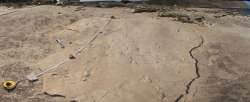5.7 million years old human-like footprints found in Greece questions our evolution
Earlier studies had suggested that all fossil hominins older than 1.8 million years came from Africa.

Challenging the theory of human evolution in Africa, researchers have found 5.7 million years old human-like footprints in Greece. Interestingly, the new footprints from Trachilos in western Crete is crucial because it has human like features with a toe size that is similar to ours and there is also ball on the sole which are not found in apes.
Earlier studies had suggested that all fossil hominins older than 1.8 million years (the age of early Homo fossils from Georgia) came from Africa, leading most researchers to conclude that this was where the group evolved. "What makes this controversial is the age and location of the prints," said one of the study authors Per Ahlberg, Professor at Uppsala University in Sweden. At approximately 5.7 million years, they are younger than the oldest known fossil hominin, Sahelanthropus from Chad, and contemporary of Orrorin from Kenya, but more than a million years older than Ardipithecus ramidus from Ethiopia, the oldest hominin known from reasonably complete fossils which has an ape-like foot.
The researchers who described Ardipithecus argued that it is a direct ancestor of later hominins, implying that a human-like foot had not yet evolved at that time. This conflicts with the hypothesis that Ardipithecus is a direct ancestor of later hominins. But the new footprints from Trachilos have an unmistakably human-like form. This is especially true of the toes, the researchers said.The big toe is similar to our own in shape, size and position. It is also associated with a distinct 'ball' on the sole, which is never present in apes.
The researchers noted that during the time when the Trachilos footprints were made, a period known as the late Miocene, the Sahara Desert did not exist and savannah-like environments extended from North Africa up around the eastern Mediterranean. Furthermore, Crete had not yet detached from the Greek mainland.
The study published in journal Proceedings of the Geologists' Association hints that our ancestors could have spread across south-east Europe and Africa. The print was discovered on a sedimentary rock whose formation dates back to 5.6 million years ago when Mediterranean Sea dried out for a short time.
(With IANS inputs)